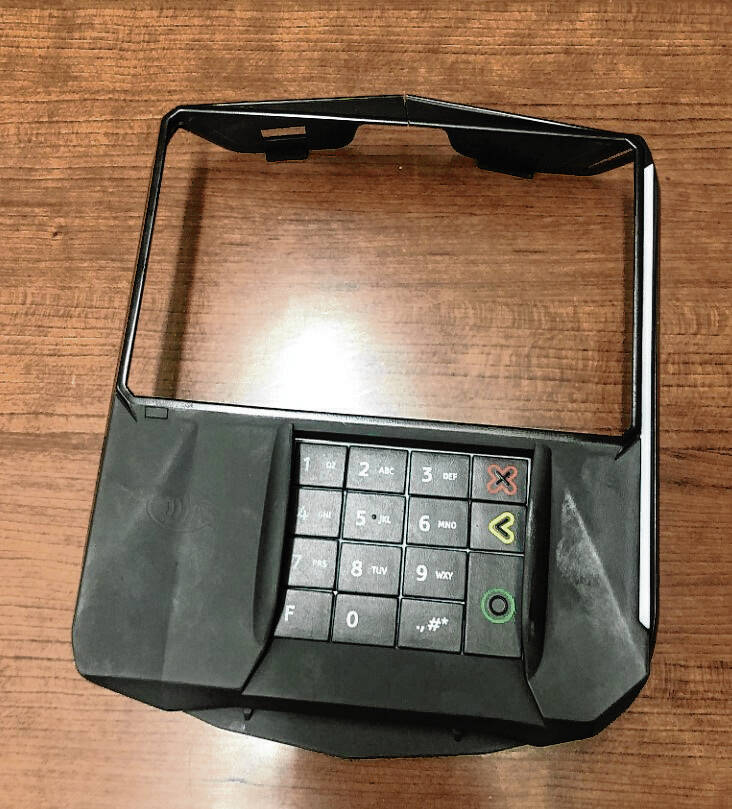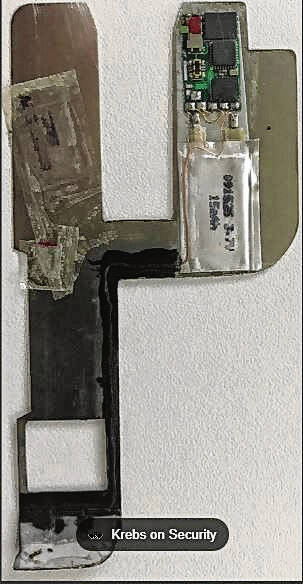Credit card skimming has been around for a long time, but it isn’t often someone is arrested for the crime.
Two men were arrested last week following an attempt to skim credit cards at the Greenwood Walmart on Emerson Avenue.

On Nov. 8, Walmart Asset Protection associates at the store witnessed two men later identified as Aleksandras Denisovas, 48, and Tom Kauppila, 52, install card skimming devices at self-checkouts at the store, according to probable cause affidavits filed with Johnson County Magistrate Court.
On video footage from the store, Denisovas can be seen installing two card skimmers, while Kauppila stands next to him, seemingly in an attempt to block store associates’ view of Denisovas, court documents say.
Since the store associate witnessed the devices being installed, they were immediately taken off and it is believed no one had their information stolen from this incident, said Matt Fillenwarth, Greenwood’s assistant chief of police.
After witnessing the card skimmer installation, the loss prevention associate followed the men out of the store and were able to direct police to their location, court documents say.

When police asked them questions, they didn’t get far. Denisovas declined to speak at all, while Kauppila answered just one before saying he didn’t understand what police were asking, court documents say.
The Johnson County Prosecutor’s Office and the Greenwood Police Department continue their investigation into the matter with criminal charges expected to be filed upon the conclusion of their investigation, said Lance Hamner, prosecutor.
Detectives are still trying to get additional information from the men and looking into possible connections to card skimming incidents that have been recently reported in nearby places, Fillenwarth said.
The men are not U.S. citizens and at least one of them is from Finland. They have been transferred to the custody of U.S. Immigration and Customs Enforcement, Hamner said.
About card skimming
The prosecutor’s office is calling this “an alarming increase” in credit card skimming. Credit card skimming occurs when criminals steal credit card data and then make charges to the card.
“It’s like stealing your credit card without actually having it in possession,” Hamner explained. “And it’s the theft that keeps on stealing. Skimming is a really low blow to a victim. It may not involve pulling a gun or knife on the person but skimming is no less an act of theft and the thieves continue stealing from you until the card gets cancelled. It can rack up thousands of dollars if not caught immediately.”
The crime of card skimming, or as it is legally called possession of a transaction duplication device, has been around for years and has typically been found at ATMs and on gas station pay-at-the-pump card readers, Fillenwarth said. Old-style devices, called shimmers, are hard to spot because they are installed on the inside of a card reader and the untrained eye wouldn’t notice there was anything amiss, he said.
Newer-style devices such as the ones recovered with this incident are dupe of a card reader cover and can also be hard to detect. The devices were installed right over the top of the card readers at the self-checkouts. The devices included a pin pad that would have collected pin numbers along with the credit card numbers of the cards used, Fillenwarth said.
Typically after skimmers or shimmers are installed, criminals wait nearby to await transmission of the card information via Bluetooth or radio waves. Once they collect card data, they typically sell that on the dark web or use it themselves to purchase items online, Fillenwarth said.
Oftentimes, police find the skimming devices or credit card companies report that information has been stolen, but rarely do they catch someone in the act of skimming. Criminals typically take measures to obscure their identity while installing the devices, which makes it hard for police to identify suspects, he said.
Stealing credit card information is taken seriously because it can be used to steal over and over, Hamner said.
“Because skimming demonstrates a clear intent and plan to continue stealing, we prosecute this crime aggressively. We will seek substantial jail sentences on individuals convicted of this crime. Organized, planned stealing should land a thief in a cage with a big lock,” Hamner said. “It’s as simple as that.”
How to avoid skimmers
Since many types of skimmers and shimmers are installed inside card machines or are designed to blend well with the card reader, it may be impossible to spot some of the devices.
However, consumers can look for signs that could point to tampering, Hamner said.
Here are some of those signs:
- Are buttons on a keypad too hard to press? Some skimmers place a device over the actual keypad to record the keystrokes.
- Does any part of the machine, but especially the card reader, look out of place? Be aware if the color or material looks or feels different from the rest of the machine.
- Does the card reader feel flimsy? ATMs and pay stations at gas pumps are mass-produced and generally quite sturdy. If a card reader wobbles or is loose, it may have been added on by a criminal.
If a consumer spots a device that looks suspicious, they should firstly not use the machines, and secondly alert store employees and the police to the device, Hamner said.
What to do if you’ve been skimmed
Fillenwarth has been a victim of card skimming himself twice. He thinks it likely happened on a gas pump both times, based on the timing, he said.
Both times it happened to him, the card was used to purchase several expensive items such as a camera, clothing and a designer handbag before it came to his attention. It was eventually found after the criminals failed to change the shipping address on an item they ordered and it arrived at Fillenwarth’s home, he said.
Luckily, it was easy to report the crime to his card company and they fixed the problem right away and were able to reverse the charges and send him a new card right away, he said.
Consumers who believe their card has fraudulent charges should take the following steps, Hamner said.
- First, don’t feel ashamed. It can happen to anyone.
- Contact your credit card company — or in the event of a debit card, your bank. Many times a refund is possible.
- Review recent transactions — particularly at restaurants, ATMs, or gas stations — and see in retrospect if anything seemed out-of-place or suspicious.
- If you have an idea of where a skim might have happened, notify the police.






